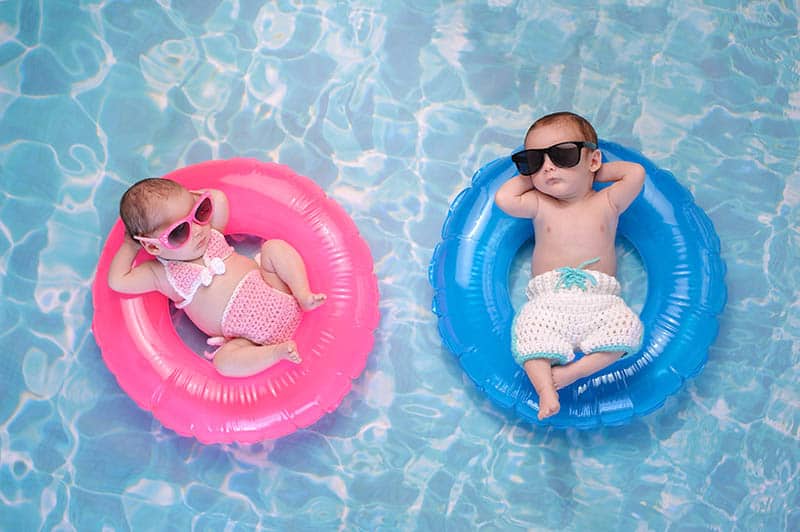Ah, swimming…. a relaxing form of exercise that also doubles as a fun activity. A lot of moms can’t wait to share that joy with their little one, but the question of when can baby go in pool remains.
Technically, they can go in the water from the moment they are born, BUT, it is certainly not recommended.
This is largely due to the fact that newborns and babies lack the ability to regulate their body temperature, hence why they like being next to their mother’s warm bosom all the time.
If you take them swimming in any body of water where you can’t adjust the temperature easily, your little one will just end up contracting a nasty cold.
Definitely something you want to avoid.
This ability has developed slightly by the time a baby is nearing 6 months of age, which is around when it’ll be a lot safer to take your baby swimming.
I’d still restrict any aquatic fun to swimming pools, though, because it’s a more controlled environment.
If you don’t own one yourself, or there are no public swimming pools nearby, get a kiddie pool if you really want your child to experience the joys of water. It’ll be like a deluxe bathing experience for them.
Water Safety Tips
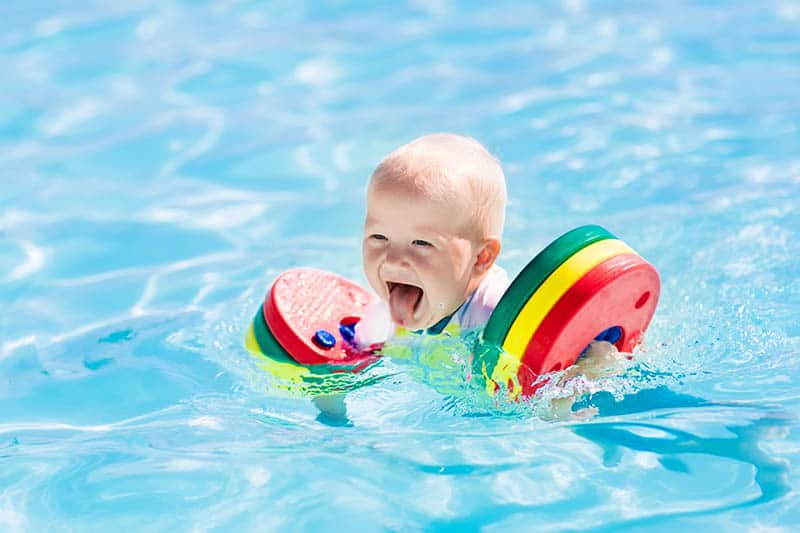
The correct time for when a baby can go in a pool depends heavily on how prepared you are to keep it safe.
1. Constant adult supervision
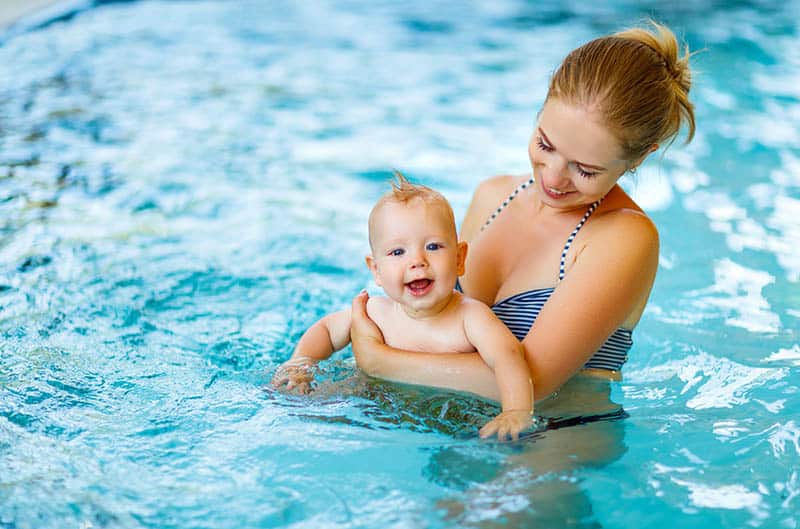
If you’re using a kiddie pool however, you aren’t necessarily going to be holding them in your arms.
If this is the case, you want them to be within arm’s reach so you can react fast enough should they accidentally fall down, have their head below the water, or want to drink it (let’s face it – this last one is bound to happen!).
It’s important to remember that young babies might not have the strength to lift themselves back up after falling down.
Besides, they weren’t the ones that decided to go swimming, making it your responsibility to keep an eye on them.
This goes doubly for any public swimming pools, rivers, lakes, or similar. They can either be too cold for your baby, too unsanitary, or both.
Plus, rivers and such tend to have strong currents so you’ll need to stick real close to them to remove as much risk of the currents pulling them away as you can.
2. Your safety
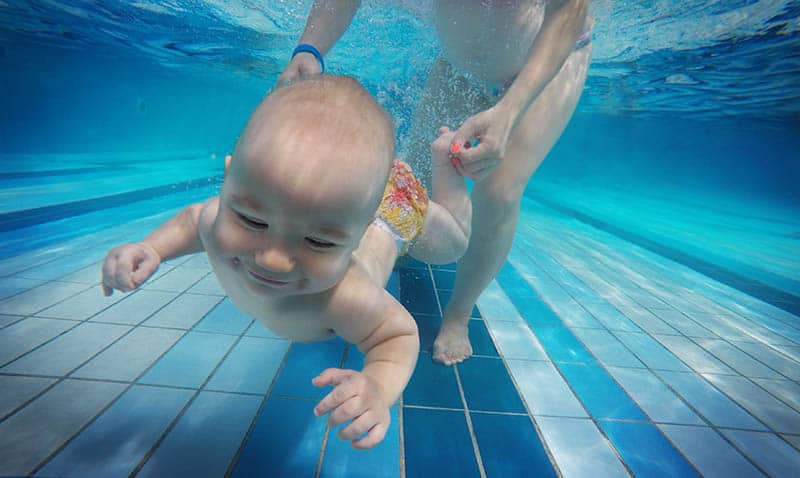
This usually takes about 6 weeks time, though you’re only good to go once a healthcare professional has deemed the period over.
3. Flotation devices

This doesn’t mean that you can leave them unattended, just that you can give them a little more freedom.
It’s about at this time that your little one will start to spread their wings a bit more, their water wings to be precise, or inner tube or life jacket, depending on what they are using at the time.
While all of these are safe enough on their own, the first rule still applies – all young children under five should be under constant strict touch supervision (within arm’s reach) until they’ve actually learned how to swim.
This is the standard set out by the AAP (The American Academy of Pediatrics) and should be adhered to at all times.
The reason for this is that even flotation devices can be a drowning hazard for the child should they tip over.
Even adults can have serious trouble righting themselves after an incident like that.
4. Sunscreen
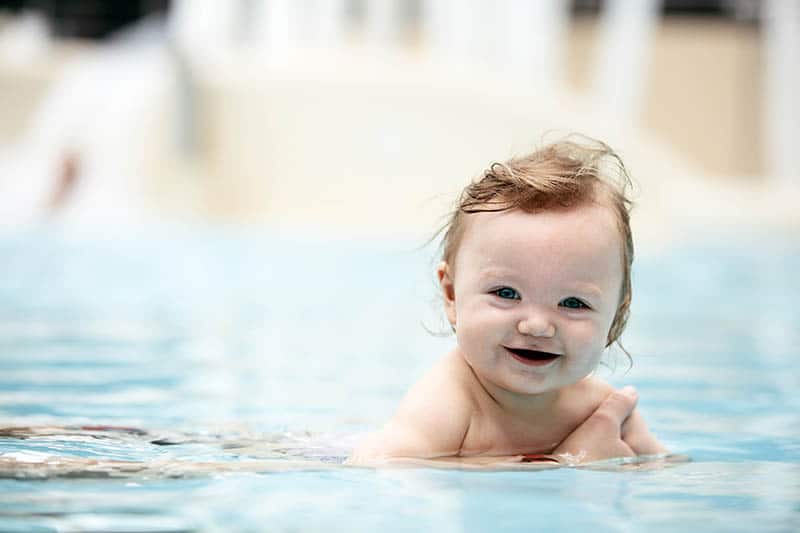
Sun’s ultraviolet rays, sunscreen plays an essential role in summer beach outings – and any other sort of outing in the heat in general.
Remember, your baby’s skin is very sensitive and it’s going to need to be protected from the sun with an SPF (Sun Protection Factor) of at least 50.
That said, you shouldn’t be using sunscreen on your adorable little child until they’re about six months of age due to the very same reason, skin sensitivity and fragility.
This is also another reason why you should avoid a swimming trip before your baby is at least 6 months old, as you simply cannot let them go out in the blazing summer heat without protection.
You could use some UV protective clothing in the meantime, but that might not do enough.
Make sure to always get child-friendly sunscreen – something with zinc oxide preferably and that specifies that it’s friendly to people with sensitive skin.
5. Swim diapers

Nobody wants to be trotting around in an utterly soaked nappy.
A swim diaper is different from the regular ones in the fact that it lacks the absorbent layer and its sole purpose is to keep the child’s solid poop in.
6. Childproofing your pool
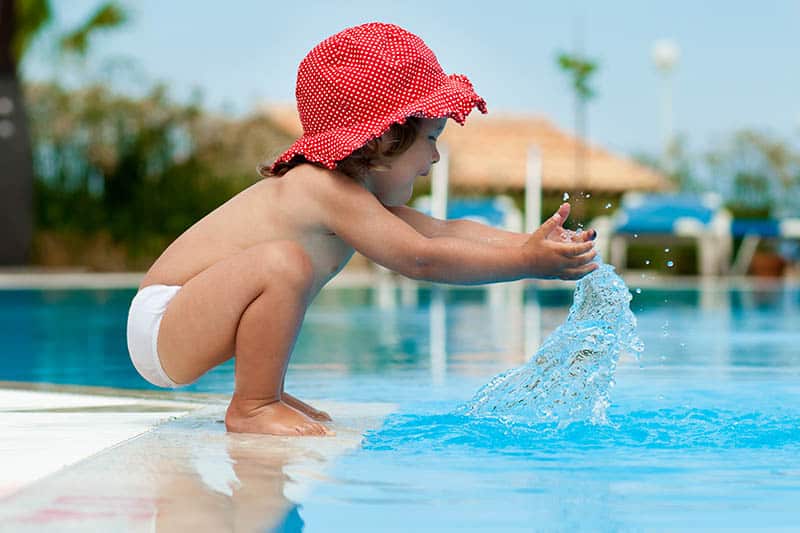
That would be an absolute nightmare.
This is less about when can baby go in a pool, and more when they can’t, and that’s when it’s in an unsafe environment.
The standard-issue size for child protection pool fencing is four feet of height. This ensures they won’t be able to get in even if they’re more dexterous than their peers.
Do make sure to check the fence and the gate every now and again to make sure that it’s not broken and that it still locks and unlocks properly.
No oversights are allowed when it comes to worrying about the safety of our youngest family members and proper pool fencing is a big priority when it comes to home pool safety.
The same rule applies if you have an outdoor hot tub, spa, or any other pool of water nearby that a young child could wander into.
7. Swimming lessons
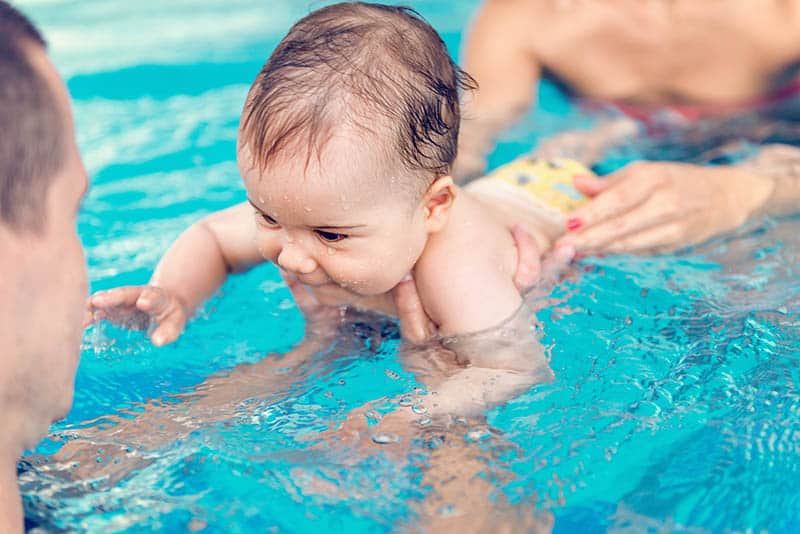
This usually happens anywhere from when they are about a year old to 4 years of age.
It’s also yet another activity where the mother (or father) and the baby can get to bond with one another over an activity they can both enjoy.
The benefit of taking your baby to swimming classes at an early stage of their developmental process is that you severely reduce the risk of drowning.
This is because they’ll learn the techniques required to stay afloat long enough to call out for help.
The best case scenario is that this sort of thing never happens, but it helps having that extra layer of safety just in case.
If you haven’t had the chance to do so yet and your child has outgrown this period, please make sure to teach them how to swim either yourself or by taking them to swimming lessons.
Once they’re four years of age, they should already know how to fend for themselves and explore the wonders of both regular and salt water.
You’ll finally be able to release them from touch supervision, though they should still have someone nearby just in case.
That should go for any person regardless of how old they are as accidents can still happen.
8. Don’t let the baby swim with diarrhea

It’s because letting diarrhea loose into the pool spreads nasty bacteria into the pool water, mixing with the already hazardous pool chemicals that your baby could potentially swallow.
This is likely to cause all manner of nasty infections and water illnesses.
It will ultimately make the whole pool unusable until it’s fully cleaned and safe to get back into, ruining everyone’s fun and enjoyment.
It’s not about when can a baby go in the pool, but rather when they can’t, and an upset tummy definitely qualifies as the latter.
If your baby is suffering from a loose stool, the water can wait – it’s not going anywhere. Besides, you shouldn’t be making your baby do anything strenuous and should just let them rest until the issue passes.
Once they’re back to running at full capacity, feel free to enjoy the watery pleasures of swimming pools again.
9. Timing your little ones watery excursions
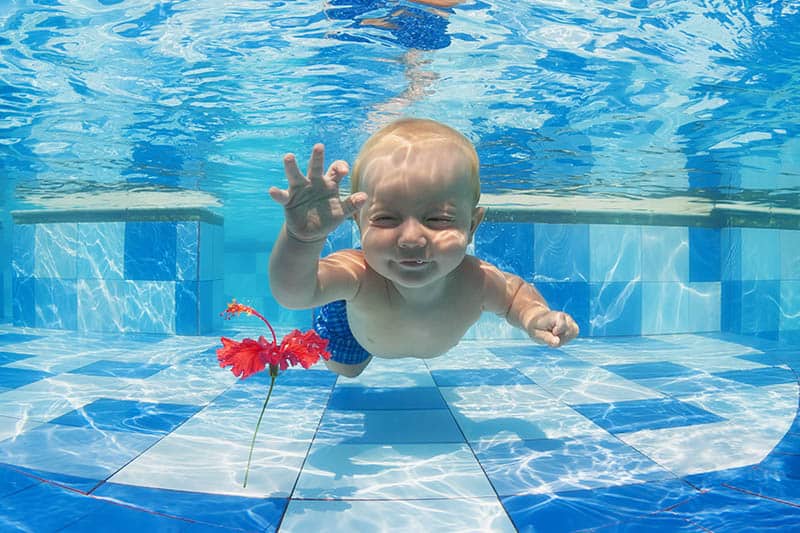
When you start them off initially, limit their exposure to water to about 10 minutes or so or until you see them grow uncomfortable or shiver.
This touches back on the issue of babies being unable to regulate their body temperature.
Once your baby grows to around that 6 month period, you can extend the time to about 30 minutes or so, but nothing more.
Once they cross the 3-4 year threshold, you can let them stay in the water as long as they like since they’ll be able to properly relay the notion of wanting to get out of the water, or will be able to do so of their own accord under adult supervision.
Where Can I Take My Baby Swimming?
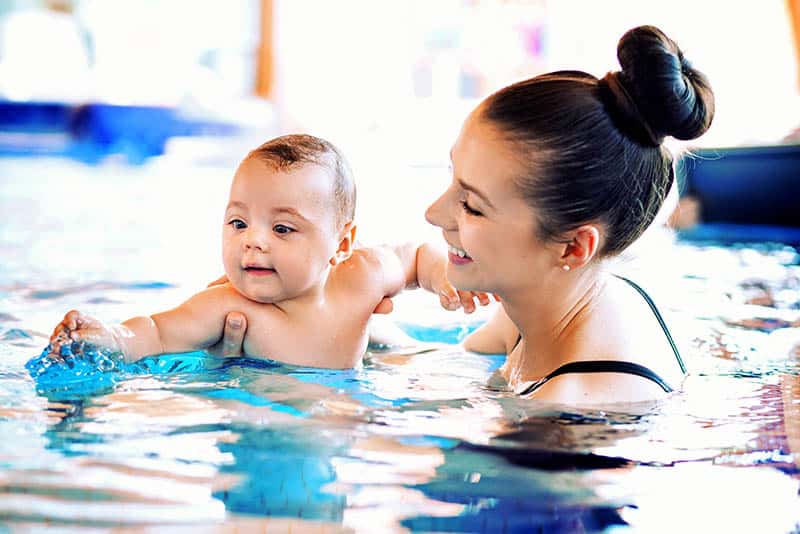
When you first start them off, you should do it in small, controlled environments, ones where you can control the water temperature and keep things nice and warm for your child.
Places like a small inflatable kiddie pool or your bathtub will be perfect for this period.
Try keeping the water as close to regular body temperature as you can (around 98 °F) and keep hold of them, letting them paddle around of their own free will and interacting with the water while making sure their head is kept above it at all times and they’re not swallowing any of it.
When they’re about 6 months of age you can start taking them to the beaches and local swimming pools, as well as any other places where the water remains relatively still.
Rivers, while fun, can be dangerous and I personally believe the added risk isn’t worth the reward, not while they’re this young.
The same rules still apply, don’t let them wander off away from arm’s reach and keep a constant eye on them.
If you have to hurry to the bathroom or something similar that might take you away from your child, make sure to have another adult that you know and trust to take your place for a bit so your baby can enjoy their time in the water.
I’d still avoid public swimming pools if at all possible due to the many pool chemicals that are used – especially chlorine – because your baby is bound to swallow some of the water unless you’re being extremely careful.
In Conclusion
The moment you resolve the dilemma of when your baby can go in the pool and start understanding all the joys involved with this new and exciting activity, as well as all of the potential risks and the safety precautions necessary to nullify said risks, you’ll feel liberated.
That’s because you’ll be able to expand your little explorer’s world view with a whole new type of “terrain”, one that covers well over two thirds of our world.
And trust me when I say that if you handle this properly, your child will have the biggest and widest smile whenever they realize that swimming time is approaching or when they see the ocean on the horizon.
Like this post? Please share or pin it for later. You can also stay in the loop and follow us on Facebook, Instagram or Pinterest.
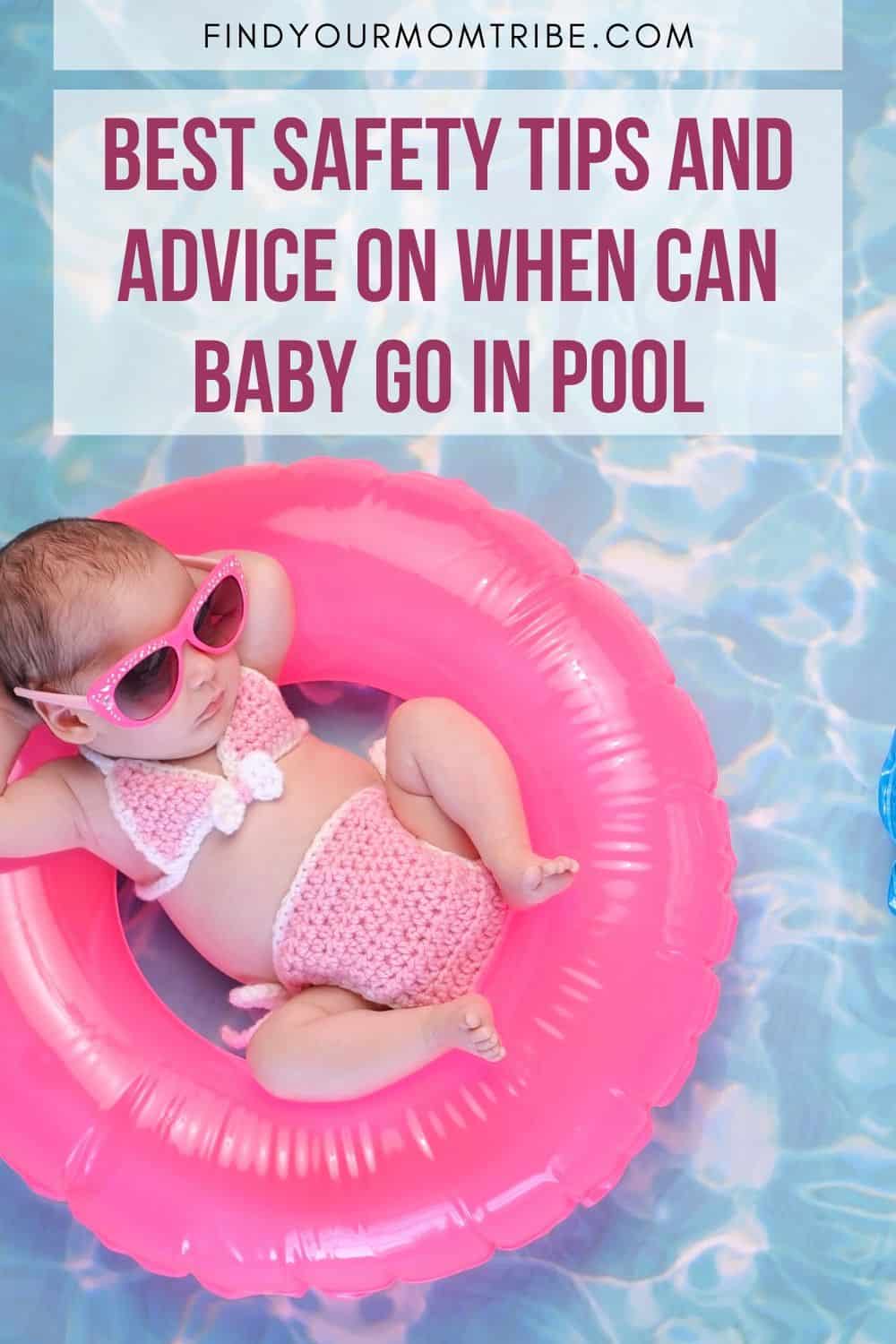
This post contains affiliate links. Please see our full disclosure for more info.

